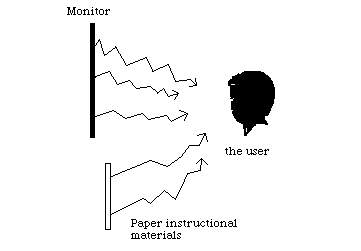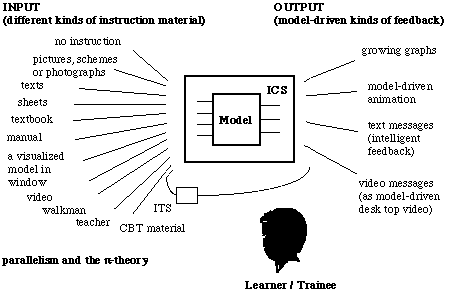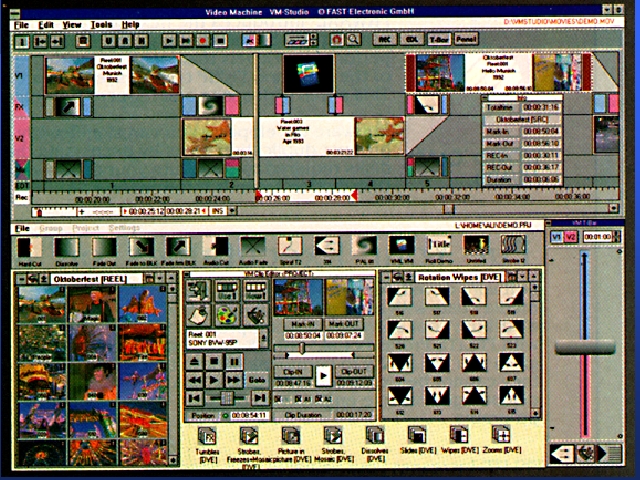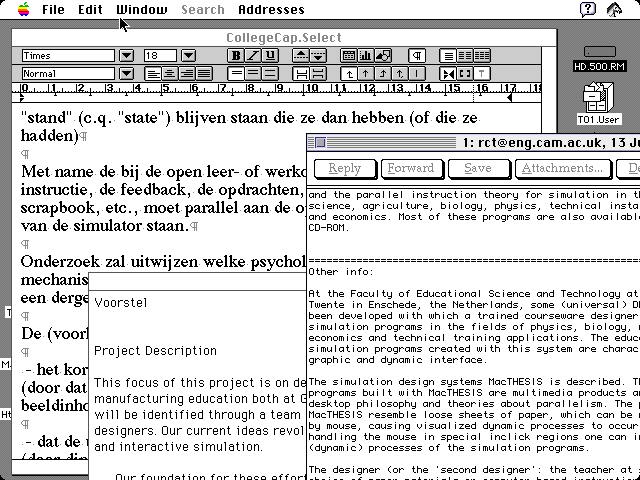backgrounds & references
 |
 |
 |
| Figure 1. The parallel information flows - simultaneous - from screen or paper to the user. |
Information can be categorized on the basis of its contents (domain), appearance (picture or text), size and modality (visual, auditory, tactile, olfactory). The philosopy behind the concept and the idea of parallelism is: using different viewports, more or bigger screen or different layers of information or modalities; parallel as far as its works (Claessens, 1999 and Tao Yu, 2002).
 |
| Figure 2. Parallelism in a learning environment (Original scheme, Min, 1992). |
| (Windows with texts, sheets or pictures, model-driven growing graphics, model-driven animations, model-driven - intelligent - textmessages or video-messages, even paper based manuals as a traditional extra windows) |
Schematically you see a simulation based open 'learning environment' in figure 2, with a lot of 'parallel' windows even 'parallel' paper-stuff. As we say: "all in view" and "all under control" (Min, 1992); "just in time" and "just in or at place" (Min, 2004).
The advantage of computer simulations is known: students can experiment with almost real situations without the dangers that experimenting always includes. The PI-theory is very usefull for building simulation environments in relation to instructional materials because it can combine the advantages of learning by experiences (open two-ways environments) and the most natural way to handel instructional and help information (one-way environments) (Min, 2001).
The problem of implementing this theory is that it was very hard to implement this in the hardware. It is technically very difficult to open two (running) windows at the same time. Therefor nine years ago (1986) the first system for designing simulations was developed. The years after there was a lot of research with this design and on the computer simulations it produced. Now we have a new system for building web-based software.

|
| Figure 3. Schematic scheme of all kinds of instruction and all kinds of feedback in task oriented working-environments (Original scheme, Min, 1994). |
| On the input side of a learning environment a lot of instruction types and/or formats are possible (such as texts, sheets, pictures, manuals, even a walkman-recorder with a instruction tape) and on the output side a lot of model-driven feedback forms (such as growing graphics, model-driven animations, intelligent model-driven 'text-messages' and/or 'video-messages') are possible. |
Schematic you see in figure 3, on the 'input side' of a learning environment a lot of different instruction types (modes of all kinds of instruction, such as texts, sheets, pictures, manuals, even a walkman-recorder with a instruction tape) and on the output side a lot of feedback forms, such as growing graphics, model-driven animations, intelligent model-driven 'text-messages' and/or 'video-messages'.
For all the designers the next designing rule is valid: the a-synchronic, simulatious processes on the 'input side' and on the same on the 'output side' of this kind of learning environments all have to be in view for the user and keep the learning process ruling.
 |
| Figure 4. An example of 'first order' parallelism. |
| It is an extreme example. A working environment with everything you want (or you think you want) in view. In litarature parallelism is also called: pan-optimum or simultaneous. |
We want to kwow or this will be important not only for simulations but also for other kinds or open learing and working environments especially in training situations and for solving complicated or less complicated tasks. All kinds of perception canals, dimensions of media (text, visuals, audia, etc.) and forms of feedback will be examine. We want to find a way to make digital environments richer and better for all kind of learning profiles. We have worked together with Holland Signaal in Hengelo (NL) and used their equipment and other things as their VR-room, animation tools, geometric models and skills (Cleassens, 2000)
 |
| Figure 5. An example of 'second order' parallelism. |
| This is a multi windowing working environment from daily life with two or three simultanious and a-synchrone applications. Here: a browser, a text processor and an mail system. In this arrangement the user is able to cut, copy and paste texts on a naturally way. |
The central research problem studied in this project is how to find theoretical base for the theoretical and fysical distance on the screen and on the desk of the learner between his computer-based problem solving space and the the coaching elements in open working, learning or doing enviroments. We do research how the concept of 'parallelism' and the 'parallel instruction theory' of Min (1992 - 1994) in simultaneous processes can be founded on psychological principles (as bad short time memory and adequate reference guides).
|
The parallel instruction theory is a theory for task oriented learning or working. The theory has 4 components from the cognitive psychology. Briefly:
If the user can not compare two or more things (rule 1) (the parallelism condition), then it is supposed that the user can not do a monitor-oriented task very well in such an environment; the application is not optimal. |
Thus: if - in an active or passive environment - the positions of all the information needed for solving a problem or doing a task is perfect (the parallelism concept) and the working memory of the user is perfect and the user can see perfectly all the cause-effect dynamics and all the new information lead to a new concept map for the user that matchs perfect with his/her old ideas (Vygotsky's zone theory), then the PI theory of Min (1992) predict that the application is optimal for task oriented learning, doing- and/or working.
The Parallel Instruction theory not only explains problems, striking effects, negative or positive, on the users in computer learning, problem solving or working on the desk top, but also in daily life and designing classrooms or television shows. For more information about the PI theory and the parallelism concept from daily life on television, with radio (passive), in exhibition halls, on computers and in web-browsers (active) in common, see my scientific rapports, my papers, my examples, my photo's, my other web-pages and the references.
2004: Experiments of Rik Min and Tao Yu (JCAL)
2004: Backgrounds of the PI theory: the Cognitive Load theory (by Tao Yu)
2004: The PI theory (poster)
2003: STW project plan (in Dutch)
2002: Experiments of Tao Yu (MSc report)
2001: NWO pro project plan (in Dutch)
2001: Waarom mislukken zoveel ICT projecten? (in Dutch)
2000: Examples, screendumps & photographs
2000: Mona Claessens (PhD interim report)
1999: The PI theory (basics) (poster)
1999: Original project plan (in Dutch)
1994: Gritter, H. (Herman), W. (Wytze) Koopal and F.B.M. (Rik) Min,
A New Appraoch to Computer Simulations; Interact, European Platform for Interactive Learning, Vol. 1, no. 2, ISSN 0929-4465.
1995: Schaick Zillesen, P.G. van, F.B.M. (Rik) Min, M.R. Gmelich Meijling and B. Reimerink,
Computer support of operator training based on an instruction theory about parallelism. Kluwer Academic Publishers (Eds: M. Mulder, W. Nijhof en R. Brinkerhof). ISBN 0-7923-9599-9. p.209-226.
1995: Rik Min,
Simulation Technology and Parallelism in Learning Environments; Methods, Concepts, Models and Systems. Book. Publisher: Academic Book Center (ABC), De Lier (1995). ISBN 900-5478-036-3.
1996: Rik Min,
Parallelism in working-, learning- and do-environments. The Parallel Instruction Theory for Coaching in Open Learning Environments for Simulation. (Proceedings of the society for computer simulation International (SCS) (Eds. A. Verbraeck & P. Geril)
1999: Rik Min,
Interactive Micro-worlds on the World Wide Web (based on research about the parallel instruction theory and the concept of parallelism). Int. J. of Continuing Engineering, Education and Long-life Learning, vol.9, no.2/3/4, p.302-314, ISSN 0957-4344.
1994: Rik Min (1994),
Parallelism in open learning and working environments. Britsh Journal of Educational Technology, Vol. 25, No. 2, pp. 108-112. ISSN 0007-1013.
| == Advertisement == |

|
| Figure 6. My first advertisement in 'Byte' (Byte, March, 1996). |
| In this advertisment some information about my book about parallelism (up-left) and my cd.rom with a lot of prototypes with parallel instructions (down-left) is shown. |
Enschede, 1999; updated in 2001, 2003 and 2004.